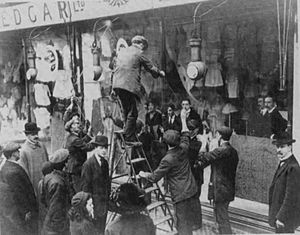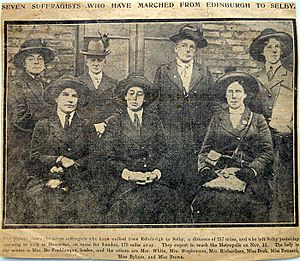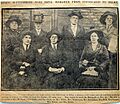Sarah Benett facts for kids
Sarah Barbara Benett (born in 1850 – died on February 8, 1924) was a brave woman who fought for women's right to vote. People who fought for this right were called suffragettes. Sarah was a member of two important groups: the Women's Social and Political Union (WSPU) and the Women's Freedom League (WFL), where she was also the Treasurer.
She was one of the "Brown Women" who walked a very long way from Edinburgh to London in 1912 to spread their message. Sarah also went on a hunger strike while in Holloway Prison. This meant she refused to eat to protest. Because of her courage, she received special awards: the WSPU's Hunger Strike Medal and the Holloway brooch.
Contents
Early Life and Helping Others
Sarah Benett was born in St Pancras, London, in 1850. She was one of nine children. Her father, William Morgan Benett, was a lawyer.
Before she joined the fight for women's votes, Sarah was already working to make society better. She started a special kind of shop called a co-operative society in the village where she grew up. This was in the New Forest area of Hampshire. A co-operative society is a business owned and run by its members, who share the profits.
After her mother passed away in 1894, Sarah moved to Burslem in Staffordshire. There, she started another co-operative society and a general store in a nearby town called Hanley. She managed this store herself. Sarah also worked hard to improve the health and safety of workers in the pottery factories in Staffordshire Potteries. She tried to get a ban on using lead in pottery glaze, which was very dangerous for the workers.
Fighting for Women's Rights
In 1907, when Sarah was 57 years old, she went to a meeting where Flora Drummond was speaking. Flora was a powerful speaker for women's rights. Sarah immediately knew that this was the cause she needed to support. She joined the Women's Social and Political Union (WSPU) and the new Women's Freedom League (WFL).
Later that year, she was arrested. This happened when she joined a group from the WSPU who were trying to speak to members of the House of Commons. She refused to pay a fine of 20 shillings, which was a lot of money back then. Because of this, she was sent to prison for 14 days.
In July 1907, another famous suffragette, Christabel Pankhurst, stayed with Sarah while campaigning. Sarah also helped start the Women's Tax Resistance League. This group believed that women should not pay taxes if they did not have the right to vote. Sarah herself became a tax resister. In 1908, she represented the WFL at a big international meeting for women's suffrage in Amsterdam.
Sarah also joined the New Constitutional Society for Women's Suffrage (NCSWS). From 1909 to 1910, she was the Treasurer of the Women's Freedom League. She then decided to focus all her energy on the WSPU, which used more direct and sometimes militant actions.
On 'Black Friday' in 1910, Sarah was one of 120 women arrested. They were protesting outside the House of Commons. Many women were hurt by the police that day.
Sarah took part in the WSPU's campaigns where they broke windows in 1911 and 1912. This was a way to get attention for their cause. In 1912, she was sent to Holloway Prison for three months. She was released early because she went on a hunger strike. For this brave action, she received the special Hunger Strike Medal and Holloway brooch from the WSPU.
Even at 62 years old in 1912, Sarah kept her spirits up in prison. She asked the Home Office (a government department) for skipping ropes and balls so the suffragette prisoners could stay fit. This request made some people in the Home Office laugh.
While in Holloway, Sarah was friends with another prisoner, Kate Williams Evans. When Kate was released, Sarah wrote a note to her maid saying: 'Miss Evans will be my guest till she is a little stronger. She has been starving so treat her as an invalid...' Sarah's signature is in an autograph book collected by Kate in Holloway. This book also has the signatures of other famous suffragettes like Emily Davison and Emmeline Pankhurst. Sarah became good friends with Emily Davison and even helped her secretly get a watch into Holloway Prison. In 1916, Sarah organized a yearly trip to Emily Davison's grave.
The Long March
In 1912, Florence Gertrude de Fonblanque decided to organize a long march from Edinburgh to London. The goal was to bring more attention to women's right to vote. Only six women, including Florence, Agnes Brown, and Sarah Benett, started the march on October 21, 1912.
As they walked from Scotland to London, they collected signatures for a petition and got a lot of attention from newspapers. Florence made sure they all wore brown clothes with green ribbons and badges. Because of this, they became known as the "Brown Women." They followed the route of the A1 and were joined by important people along the way. One day, near Berwick, they walked over 30 miles! By then, there were seven marchers, and they were welcomed by the local Member of Parliament.
Their group slowly grew. When they passed through Grantham in November, there were twelve walkers. Finally, they reached London on November 16, 1912. They took the tube to Trafalgar Square, where they entered to music and cheers. Sarah Benett later remembered that she "had walked her shoes off trying to get signatures to petition."
Later Years
In 1913, Sarah was involved in breaking windows at Selfridges department store. This was a protest against the government taking back a bill that would have given women the right to vote. For this, Sarah received a six-month prison sentence.
Until her death in 1924, she continued to be involved with the Women's Tax Resistance League. In her later years, Sarah Benett lived in Finchley in North London. She died in February 1924 and never married.
A book about her life, called Rebel With a Cause: The Life and Times of Sarah Benett, 1850-1924, Social Reformer and Suffragette, was published in 2018.
Images for kids
See also
 In Spanish: Sarah Benett para niños
In Spanish: Sarah Benett para niños







